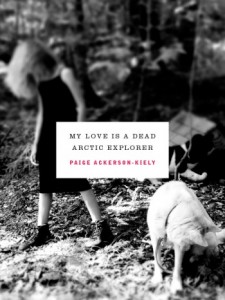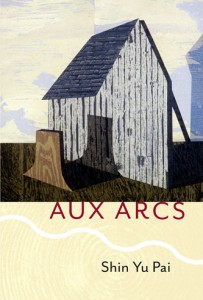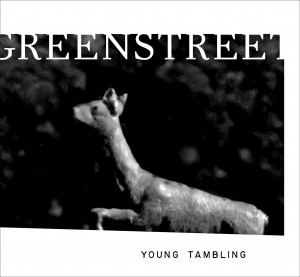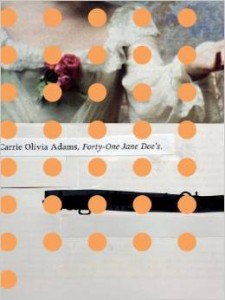By: Kristina Marie Darling
All too often, women poets interrogate the predominantly male forms of discourse they have inherited; yet at the same time, they reproduce received ideas about temporality in a fairly uncritical manner. Recent years have seen numerous books by female writers that present time as linear, an orderly succession of events that can be easily understood, mastered, and forgotten. Even in the midst of stylistic innovation, these traditional models of time and history go unquestioned.
Five contemporary women poets, however, have begun to explore alternatives to predominantly linear models of time and history. Throughout their work, time is shown to be recursive, and history a palimpsest that is written, erased, and rewritten. These ambitious philosophical claims are embodied most visibly in each writer’s treatment of the image, which is revealed as historically sedimented—a locus where thought, affect, and the residue of culture converge and accumulate. The complex, multifaceted treatment of every image suggests the impossibility of locating experience within a single temporal moment, as even the most commonplace event bears the enormous weight of history.
1. Darcie Dennigan
 Darcie Dennigan’s Madame X (Canarium Books, 2012) understands time through its effects on the physical body. In Dennigan’s work, the physical body resists being situated within a single historical moment. Rather, the speaker’s physical being, or at least her experience of it, is mediated by centuries of social and cultural discourse. The body is revealed as discursively constructed, knowable only by the names and descriptions we affix to it. The speaker’s very “bones” are inscribed and reinscribed with received ideas from the world around her, ranging from arcane to contemporary, religious to aesthetic. She “bleeds” for the sake of art and worries whether the revered academy knows she’s “not . . . pure.”
Darcie Dennigan’s Madame X (Canarium Books, 2012) understands time through its effects on the physical body. In Dennigan’s work, the physical body resists being situated within a single historical moment. Rather, the speaker’s physical being, or at least her experience of it, is mediated by centuries of social and cultural discourse. The body is revealed as discursively constructed, knowable only by the names and descriptions we affix to it. The speaker’s very “bones” are inscribed and reinscribed with received ideas from the world around her, ranging from arcane to contemporary, religious to aesthetic. She “bleeds” for the sake of art and worries whether the revered academy knows she’s “not . . . pure.”
The speaker of the poems in Madame X constantly tries to shake the enormous weight of these competing cultural paradigms:
And on what might have been her bedside table is the book called Don Quixote. It is inscribed to Mary by its author, Cervantes: And here, Virgin, is the child of my understanding. We talked about it every day, taking up three seats in at the very back of the bus, must have seen the house in a vision.
Although making ambitious claims about time, history, and the body, Dennigan often engages the reader through her humorous pairings of historical and contemporary culture (for example, “Don Quixote” and the “Virgin” appear at the “very back of the bus”). Through her juxtapositions, she calls our attention to the incompatibility of received ideas that have been inscribed onto the physical body. In doing so, she also highlights the lack of agency inherent in the creation of these histories.
2. Paige Ackerson-Kiely
 Paige Ackerson-Kiely’s My Love is a Dead Arctic Explorer (Ahsahta Press, 2012) shows a similar concern for the ways that history and modernity intersect in even the most commonplace endeavors. This ambitious philosophical vision is reflected in Ackerson-Kiely’s smallest stylistic decisions, particularly her treatment of recurring imagistic motifs. Like Dennigan, Ackerson-Kiely frequently inscribes and reinscribes the same image with myriad possibilities for interpretation. This proliferation of meaning serves to illustrate the emotional weight that even the most commonplace objects accumulate as a result of time passing. The poetic image not only bisects time, but also serves as a locus where thought and affect begin to accumulate. Consider “Have Never Been a Lonely God”:
Paige Ackerson-Kiely’s My Love is a Dead Arctic Explorer (Ahsahta Press, 2012) shows a similar concern for the ways that history and modernity intersect in even the most commonplace endeavors. This ambitious philosophical vision is reflected in Ackerson-Kiely’s smallest stylistic decisions, particularly her treatment of recurring imagistic motifs. Like Dennigan, Ackerson-Kiely frequently inscribes and reinscribes the same image with myriad possibilities for interpretation. This proliferation of meaning serves to illustrate the emotional weight that even the most commonplace objects accumulate as a result of time passing. The poetic image not only bisects time, but also serves as a locus where thought and affect begin to accumulate. Consider “Have Never Been a Lonely God”:
I have never been a lonely god
but I understand the way rocks
just lie there waiting to be formed into rocks.
Here the simple image of rocks becomes an emblem for potentiality, the anticipation of time’s inevitable formation of the individual self. The poetic image, like the rocks mentioned here, accrues meaning through its existence in time. Passages like this one suggest both powerlessness (“rocks / just lie there waiting . . .”) and agency (“I have never been a lonely god / but I understand . . .”). The image becomes a palimpsest, upon which the speaker sees the world around her projected. Later in the book Ackerson-Kiely writes:
A native to this dirge of gray mountains, your hand feeling along the granite boulders, why here & how to make it defensible, your hand pushed deep in your pocket as a doleful rampart holding you upright, your hand tossing down smooth white stones, that you shall lead us home—
The image of “rocks” is imbued with new possibilities for interpretation, complicating everything that came before. While the “rocks” mentioned earlier convey a sense of power, here the same item has been tossed from someone else’s hands. The agency the speaker once possessed has been displaced. As the collection unfolds, the same motifs, objects, and everyday items appear in novel contexts, allowing the same images to serve as points of entry to multiple, and often very different, temporal moments. Ackerson-Kiely subtly critiques traditional models of time and history, which fail to acknowledge the ways that a single experience is often mediated by a variety of cultural, religious, and personal histories.
3. Shin Yu Pai
 Along these lines, Shin Yu Pai’s stunning collection, Aux Arcs (La Almeda Press, 2013), explores the ways the poetic image can be illuminated by creative work in other disciplines, most notably photography. The image—in Pai’s poetry as well as in the mass culture portrayed in her photographs—accrues the residue of social upheavals, artistic movements, and the speaker’s own emotional states. This pairing of text and image conveys a powerful critique of linear models of time, which often fail to acknowledge the complex histories contained within any given moment. Consider “Main Street”:
Along these lines, Shin Yu Pai’s stunning collection, Aux Arcs (La Almeda Press, 2013), explores the ways the poetic image can be illuminated by creative work in other disciplines, most notably photography. The image—in Pai’s poetry as well as in the mass culture portrayed in her photographs—accrues the residue of social upheavals, artistic movements, and the speaker’s own emotional states. This pairing of text and image conveys a powerful critique of linear models of time, which often fail to acknowledge the complex histories contained within any given moment. Consider “Main Street”:
I try to describe spittle
coming in my direction,
thinking of our next-door
neighbors back “home”
proud to wag
the Southern Cross
displays we bristle
against & those which
we resign ourselves to
Here the image of “the Southern Cross” operates at the intersection of religion, politics, and regional culture. Functioning as an emblem for social norms as well as alienation from that same society, the “Southern Cross” itself is constantly in flux. In these poems images are processual, their meaning unfolding and accumulating over time. “Main Street” appears shortly after a picture of a timeworn animal skull, an apt metaphor for the erosion and sedimentation of meaning that we see in the text. Like Ackerson-Kiely and Dennigan, Pai presents these small details as points of entry into ambitious questions about time and history, suggesting the impossibility of creating simple cause and effect relationships when each image, each landscape, and each piece of ephemera contains worlds.
4. Kate Greenstreet
 Kate Greenstreet’s Young Tambling (Ahsahta Press, 2013) also explores the connection between text and image. Frequently presenting fragments of text, as well as photographs that are purposefully complicated by their captions, Greenstreet calls attention to the ways that the residue of history, culture, and emotion obscures what meaning there is to be found in one’s immediate surroundings. Greenstreet is also interested in the ways that even the simplest experiences of temporality are mediated by history. Rather than excavating vast histories, though, Greenstreet’s speakers frequently seek to escape them. She writes:
Kate Greenstreet’s Young Tambling (Ahsahta Press, 2013) also explores the connection between text and image. Frequently presenting fragments of text, as well as photographs that are purposefully complicated by their captions, Greenstreet calls attention to the ways that the residue of history, culture, and emotion obscures what meaning there is to be found in one’s immediate surroundings. Greenstreet is also interested in the ways that even the simplest experiences of temporality are mediated by history. Rather than excavating vast histories, though, Greenstreet’s speakers frequently seek to escape them. She writes:
Just a marionette or—what else do they call it?—a dummy. Back in the suitcase. You’re the brother? I see her problem and I can’t solve it. I don’t have to write it down. I remember.
Greenstreet exhibits a similar preoccupation with the ways everyday items carry vast emotional, historical, and cultural weight. But what’s unique about Greenstreet’s work is her desire to see past this cultural detritus, and experience the world in an unmediated (or less mediated) way. This idea comes across most visibly in the speaker’s refusal to “write things down,” since she chooses instead to close her eyes and “remember.” The visual elements of the book complement this exploration of how our experience of the world is mediated, most notably as the text complicates, rather than clarifies, the meaning of the images interspersed throughout the book.
5. Carrie Olivia Adams
 Lastly, Carrie Olivia Adams’s Forty-One Jane Doe’s (Ahsahta Press, 2013) offers a graceful synthesis of poetic and scientific language. Everyday experiences become a locus for vastly different discourses—literary, scientific, and historical—which overlap and intersect as they are inscribed upon a single concrete image. Adams’s collection offers a similar critique of traditional linear models of time and history. By situating the image at the intersection of these competing discourses, Adams suggests that even the most visceral experiences bear the weight of history, particularly as personal experience serves as a point of entry to multiple, and often irreconcilable, narratives. What’s unique about her work is that she inscribes the poetic image with myriad subjective discourses, but also those that claim objectivity. Consider this passage:
Lastly, Carrie Olivia Adams’s Forty-One Jane Doe’s (Ahsahta Press, 2013) offers a graceful synthesis of poetic and scientific language. Everyday experiences become a locus for vastly different discourses—literary, scientific, and historical—which overlap and intersect as they are inscribed upon a single concrete image. Adams’s collection offers a similar critique of traditional linear models of time and history. By situating the image at the intersection of these competing discourses, Adams suggests that even the most visceral experiences bear the weight of history, particularly as personal experience serves as a point of entry to multiple, and often irreconcilable, narratives. What’s unique about her work is that she inscribes the poetic image with myriad subjective discourses, but also those that claim objectivity. Consider this passage:
The heart, my heart,
when it moves,
becomes of a paler color,
when quiescent
it is red.
In the pause
the heart is soft,
exhausted, lying,
as it were
at rest.
Here the detached, seemingly objective description found in scientific writing serves as a vehicle for communicating subjective personal experience, rather than simple facts. By forcing scientific and personal narratives to coexist within the same rhetorical space, and inscribing them onto the same image, Adams calls the notion of objectivity into question. She, too, shows us that an image can contain worlds, which speaks to the difficulty of locating any experience within a single temporal moment.
Kristina Marie Darling is the author of eighteen books, which include Melancholia (An Essay) (Ravenna Press, 2012), Petrarchan (BlazeVOX Books, 2013), and Scorched Altar: Selected Poems and Stories 2007-2014 (BlazeVOX Books, forthcoming). Her awards include fellowships from Yaddo, the Ucross Foundation, the Helene Wurlitzer Foundation, and the Hawthornden Castle International Retreat for Writers, as well as grants from the Kittredge Fund and the Elizabeth George Foundation. She is currently working toward a Ph.D. in Poetics at S.U.N.Y.-Buffalo.